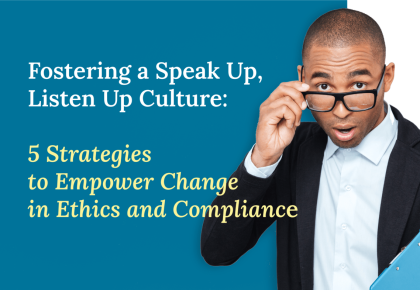Ethics Impact Your Daily Decisions
We all make many decisions during a typical day on the job. While most of these decisions are black and white, there are times when we must determine whether an action we’re contemplating crosses an ethical line. For example, should you accept ballgame tickets from a supplier, even though you think it might be against company policy to do so? Or, you discover that some of the information you’ve included in a proposal isn’t true, but if you tell the client, you know it will ruin the deal.
In many cases, choosing the crooked path may result in a short-term gain, but it can have severe consequences for you or your organization in the long run. If your employer finds out that you accepted the tickets to the sporting event, you could lose your job. And when the client realizes you fudged the figures on your proposal, he will likely take his business elsewhere – and steer others away from the organization.
The Benefits of Integrating Ethics into Decision Making
It isn’t always easy to do the right thing. There can be pressure from colleagues, customers, and in some cases, supervisors to cut corners or break the rules, and it’s easy to fall into the “everyone else is doing it” trap. But taking the time to weigh the ethical pros and cons of your decisions will benefit you and the organization in a variety of ways:
- Earning respect and trust of your coworkers and customers
- Avoiding dilemmas that could have significant legal, financial, or reputational repercussions for you and the organization
- Helping the organization maintain a favorable status within the industry
- Making a positive contribution to the development of a healthier, more productive workplace culture
- Having the peace of mind that comes from knowing you did what you believe to be the right thing
A Model for Ethical Decision-Making in the Workplace
Since making ethical decisions poses a challenge for many employees, it helps to have a framework that will lead you through the process. The Markkula Center for Applied Ethics at Santa Clara University offers the following five-step methodology to guide you in the right direction:
- Recognize an ethical issue: The first step entails having the ability to identify a potential ethical dilemma when it presents itself. You’ll need to determine whether the decision or situation could cause harm to another employee, a workgroup, or the entire organization. You’ll also have to gauge whether you must select between a good and a bad option, two good or two bad options. Furthermore, you’ll have to determine if the issue is more about what is legal or most efficient.
- Gather the facts: The more facts you can obtain about a situation, the greater the likelihood you will make an ethical decision. Take the time to gather all the relevant facts – including those that have yet to come to light. Consult with others to who the outcome of your action may impact. Don’t move forward until you feel confident that you have enough information to make the best decision.
- Evaluate the alternatives: There are several approaches you can take to assess all available decision-making options at your disposal:
-
- Deciding which choice will deliver the most good and do the least harm
- Choosing which option best protects the rights of everyone involved in the outcome
- Deciding which choice is the fairest for all parties
- Determining which option best promotes the common good
- Decide which option is most aligned with your values and “moral compass.”
- Make and test a decision: Review all the approaches listed above and determine which one is most applicable to your situation – and then make your decision. Rather than putting it out there and hoping for the best, try taking it for a “test drive” to see how you feel about it. Consider this question before acting: “If I told someone I respect what I’m about to do, how would he or she react?” If you’re unhappy with the answer, reevaluate and repeat the first three steps.
- Act and reflect: When you’re finally satisfied with your decision, it’s time to act. Implement your action in a way that best addresses the concerns of everyone who has a stake in the outcome. Assess the results and look for opportunities to improve your ethical decision-making process as you move forward.




